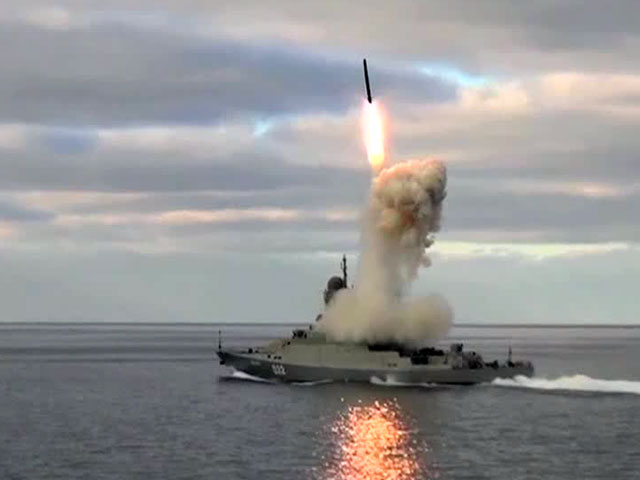Kalibr-NK Cruise Missiles Combat Record Underlines Need for it to Equip Russian Navy ships
 The Buyan-M Corvette "Uglich" launches a 3M-54 Kalibr anti-ship missile during maneuvers in the Caspian Sea. |
|||
"Decisive measures are due in order to afford
the Navy a real conventional strike capability, with the measures to include
a revision of the earlier-made steps (e.g. the governmental armament acquisition
program, shipbuilding program, research and development) and modification
of the organization and distribution of the operating forces," Klimov
says in his article. After the re-armament began several years ago, next
to nothing has been done to introduce sea-launched cruise missiles (SLCM)
to the surface warships and submarines. Of the Navy’s in-service
fleet, only four ships with the Caspian Flotilla carry the Kalibr system
(Project 11661 Gepard-class Dagestan patrol ship and three Project 21631(Buyan-M-class)
guided missile corvettes). It is they that participated in the two air
strikes against the terrorist groups operating in Syria.
In all, the ships operating in the Caspian launched a total of 44 3M-14 missiles (26 on October 7 and 18 on November 20). It is obvious, however, that the number of weapons employed is not enough to inflict unacceptable damage on the enemy possessing sophisticated layered air defenses. "The large-scale introduction of up-to-date naval precision-guided missiles is needed to beef up a salvo by more than an order of magnitude, rather than by several times only. This has to be done in the face of the economic crisis and sanctions and will call for out-of-the-box hard decisions all the way to a considerable revision of the Navy’s armament program," Klimov opined. It is known that the Russian Navy will receive ships of several classes, equipped with the Kalibr missile system from the outset, e.g. improved Project 20385 (NATO reporting name: Steregushchy-class) corvettes, Project 21631 guided missile craft, Project 22800 Karakurt-class corvettes and Project 22160 patrol ships. All of them can be fitted out with an eight-tube vertical launch system (VLS) used as part of the versatile ship-borne weapons suite. A Kalibr VLS with same number of launch tubes is installed in the Project 11356 (Admiral Grigorovich-class) frigates due to the Black Sea Fleet in the near future. The advanced Project 22350 (Gorshkov-class) frigate carries two VLS’s with a total capacity of 16 launchers. At least 15 ships of the class are expected to enter service with the Russian Navy. According to Viktor Chirkov, chief of naval operations, the ships of the class will make up the backbone of the Russian Navy’s Arctic force. |
|||
|
Our video on Kalibr family at IMDS exposition in Russia |
|||
In addition, according to open sources, the Kalibr
system will equip the future Project 23560 Leader-class destroyer as well.
The Navy expects the delivery of 12 Project 23560 destroyers in all, with
six earmarked for the Northern Fleet and six for the Pacific one. The
lead ship of the class will be built in 2023-2025 at the earliest.
However, the Kalibr can be mounted on the in-service surface combatants as well. In particular, the Admiral Nakhimov (Kirov-class) guided missile cruiser, which is being upgraded, will receive 10 Kalibr-NK VLS’s with a total of 80 launch tubes. The same goes for the Pyotr Veliky guided missile cruiser and, possibly, the third Project 1144 ship, the Admiral Lazarev. In addition, the advanced missile system may be installed in the Project 1164 Atlant-class (Slava-class) guided missile cruisers and Project 1155/11551 Fregat-class (Udaloy-class) antisubmarine warfare ships as well. The Russian Navy commander-in-chief officially voiced the need for their modernization in summer 2015. The upgrade through installing Kalibr systems may apply to the Russian Navy’s nuclear-powered attack submarines as well. The Kalibr’s missiles can be launched via the 533-mm torpedo tubes of the Project 971 Bars-class (Akula-class), Project 945 Barracuda-class (Sierra-I-class), Project 945A Condor-class (Sierra-II-class) and Project 671RTMK Shchuka-class (Victor-III) nuclear-powered attack submarines. The Project 949/949A Antei-class (Oskar-I and II-class) submarines may have their inclined P-700 Granit antiship missile launchers replaced with the Kalibr system’s missiles. The Russian Navy has so far received one nuclear-powered attack submarine capable of using the 3M-14 and 3M-54 missiles. The Severodvinsk, which is the Project 885 Yasen-class (Severodvinsk-class) lead ship, carries eight VLS’s with a capacity of 32 cruise missiles, installed aft of its conning tower. The Russian Navy is expected to operate eight Project 885 and 885M nuclear-powered attack submarines by 2023. The Kalibr can equip the Project 677 Lada-class (Petersburg), Project 636.6 (Improved Kilo) and Project 877 (Kilo) diesel-electric submarines. They also will be able to launch advanced cruise missiles via their 533-mm torpedo tubes. The need of upgrading the Russian Navy in this manner is exemplified by the ongoing operation against the Russia-banned Islamic State terrorist group in several Middle East countries. The reach of the Russian air task force in Syria, which includes the latest tactical bombers, proved to be not enough to attack targets throughout Syria, and long-range bombers had to be used. However, the volatile international situation may require the intervention of the Russian Armed Forces in remote corners of the world, which may be out of reach for the Tupolev Tu-95MS (Bear) and Tu-160 (Blackjack) strategic bombers. The Russian Navy’s lack of aircraft carries similar to the US Navy’s Nimitz and Gerald R. Ford prevents it from conducting such operations with the use of the capabilities of a carrier battle group. Presumably, Russia will have to put off the construction of aircraft carriers displacing 90,000 tons or more until 2025 at the least due to the new economic situation. Thus, the most logical solution to the problem will be the upgrade of the Navy through the large-scale introduction of the Kalibr missile system into the weapons suites of all surface combatants and nuclear-powered and diesel-electric submarines. "Actually, we have just started the re-equipment of our Navy," Maxim Klimov sums up in his article. © Copyright 2015 TASS. All rights reserved. This material may not be published, broadcast, rewritten or redistributed. |
|||


























